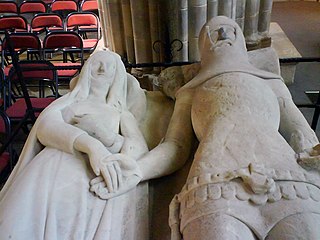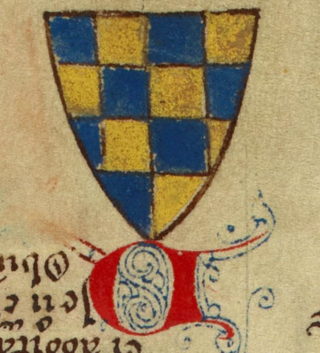
Duke of Norfolk is a title in the peerage of England, and is the premier non-royal peerage. The seat of the Duke of Norfolk is Arundel Castle in Sussex, although the title refers to the county of Norfolk. The current duke is Edward Fitzalan-Howard, 18th Duke of Norfolk. The dukes have historically been Catholic, a state of affairs known as recusancy in England.
John Fitzalan II (1223–1267), Lord of Oswestry, Clun, and Arundel, was an English nobleman and Marcher Lord with lands in the Welsh Marches.

Richard Fitzalan, 3rd Earl of Arundel, 8th Earl of Surrey was an English nobleman and medieval military leader and distinguished admiral. Arundel was one of the wealthiest nobles, and most loyal noble retainer of the chivalric code that governed the reign of Edward III of England.

Earl of Surrey is a title in the Peerage of England that has been created five times. It was first created for William de Warenne, a close companion of William the Conqueror. It is currently held as a subsidiary title by the Dukes of Norfolk.

William de Warenne, 5th Earl of Surrey was the son of Hamelin de Warenne and Isabel, daughter of William de Warenne, 3rd Earl of Surrey. His father Hamelin granted him the manor of Appleby, North Lincolnshire.

John de Warenne, 7th Earl of Surrey, was the last Warenne earl of Surrey.

William I, also referred to as William of Blois, was Count of Boulogne and Earl of Surrey jure uxoris from 1153 until his death. He was the second son of Stephen, King of England, and Matilda I, Countess of Boulogne.

The House of Mowbray was an Anglo-Norman noble house, derived from Montbray in Normandy and founded by Roger de Mowbray, son of Nigel d'Aubigny.

William d'Aubigny, 3rd Earl of Arundel, also called William de Albini IV, was an English nobleman, a favourite of King John, and a participant in the Fifth Crusade.
Nigel d'Aubigny, was a Norman Lord and English baron who was the son of Roger d'Aubigny and Amice or Avice de Mowbray. His paternal uncle William was lord of Aubigny, while his father was an avid supporter of Henry I of England. His brother William d'Aubigny Pincerna was the king's Butler and father of the 1st Earl of Arundel. He was the founder of the noble House of Mowbray.
Isabel de Warenne, 4th Countess of Surrey was an English peer. She was the only surviving heir of William de Warenne, 3rd Earl of Surrey, and his wife, Adela, the daughter of William III of Ponthieu.
Alice de Warenne, Countess of Arundel was an English noblewoman and heir apparent to the Earldom of Surrey. In 1305, she married Edmund FitzAlan, 2nd Earl of Arundel.
Maud Marshal, Countess of Norfolk, Countess of Surrey was an Anglo-Norman noblewoman and a wealthy co-heiress of her father William Marshal, 1st Earl of Pembroke, and her mother Isabel de Clare suo jure 4th Countess of Pembroke. Maud was their eldest daughter. She had two husbands: Hugh Bigod, 3rd Earl of Norfolk, and William de Warenne, 5th Earl of Surrey.

William d'Aubigny, 2nd Earl of Arundel, also called William de Albini III, was the son of William d'Aubigny, 1st Earl of Arundel and Adeliza of Louvain, widow of Henry I of England.

The de Warenne family were a noble family in England that included the first Earls of Surrey, created by William the Conqueror in 1088 for William de Warenne, 1st Earl of Surrey, who was among his companions at the Battle of Hastings. The family originated in Normandy and, as Earls, held land there and throughout England. When the senior male-line ended in the mid-12th century, the descendants of their heiress adopted the Warenne surname and continue as Earls of Surrey for another two centuries. Several junior lines also held land or prominent offices in England and Normandy.
Isabel de Warenne, Countess of Arundel was an English peer. She was widowed when she was about 17 years old, with a large estate, upon which she founded a Cistercian order convent, England's only convent to be Cistercian at the time of its founding. In 1252, she rebuked King Henry III for not paying her money she was owed.







